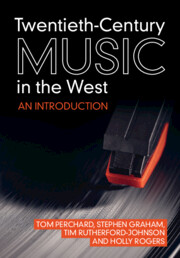Book contents
- Twentieth-Century Music in the West
- Twentieth-Century Music in the West
- Copyright page
- Contents
- Figures
- Tables
- Acknowledgements
- Introduction
- Part I Histories
- Part II Techniques and Technologies
- Part III Mediation
- 9 Recording and Production
- 10 Copyright and the Music Industry
- 11 States and Markets
- 12 Music and the Moving Image
- Part IV Identities
- Bibliography
- Index
9 - Recording and Production
from Part III - Mediation
Published online by Cambridge University Press: 15 September 2022
- Twentieth-Century Music in the West
- Twentieth-Century Music in the West
- Copyright page
- Contents
- Figures
- Tables
- Acknowledgements
- Introduction
- Part I Histories
- Part II Techniques and Technologies
- Part III Mediation
- 9 Recording and Production
- 10 Copyright and the Music Industry
- 11 States and Markets
- 12 Music and the Moving Image
- Part IV Identities
- Bibliography
- Index
Summary
‘The first thing about recording’ ambient music composer Brian Eno has written, ‘is that it makes repeatable what was otherwise transient and ephemeral’ (Eno 2004: 127). Some of the biggest changes to musical culture in the twentieth century were the result of newly emerging recording technologies. As Brian Eno (1948–) suggests, sounds that once had to be performed live could now be captured, packaged, collected and distributed in ways unimaginable in the previous century. This affected both the creation and consumption of music. When used as an instrument to manipulate or make music – a process known as ‘phonography’ (Eisenberg 1987) – the tools for sound reproduction generated textures and structures difficult to replicate in live performance. In fact, audio engineering technologies saw the advent of reverb, echo, overdubbing, splicing and digital processing, techniques essential to genres as diverse as musique concrète, acousmatic sound art, dub, electronica, hip-hop and turntablism. Not only did these technologies give rise to new types of musician, from the studio engineer and producer to the DJ, but they also encouraged collaborative ways of working rarely seen before.
- Type
- Chapter
- Information
- Twentieth-Century Music in the WestAn Introduction, pp. 229 - 252Publisher: Cambridge University PressPrint publication year: 2022



